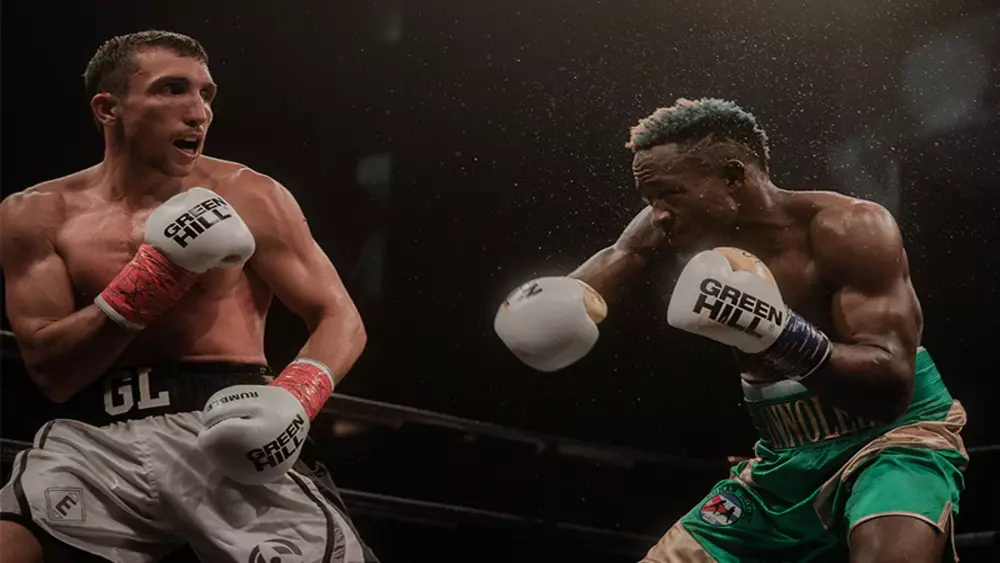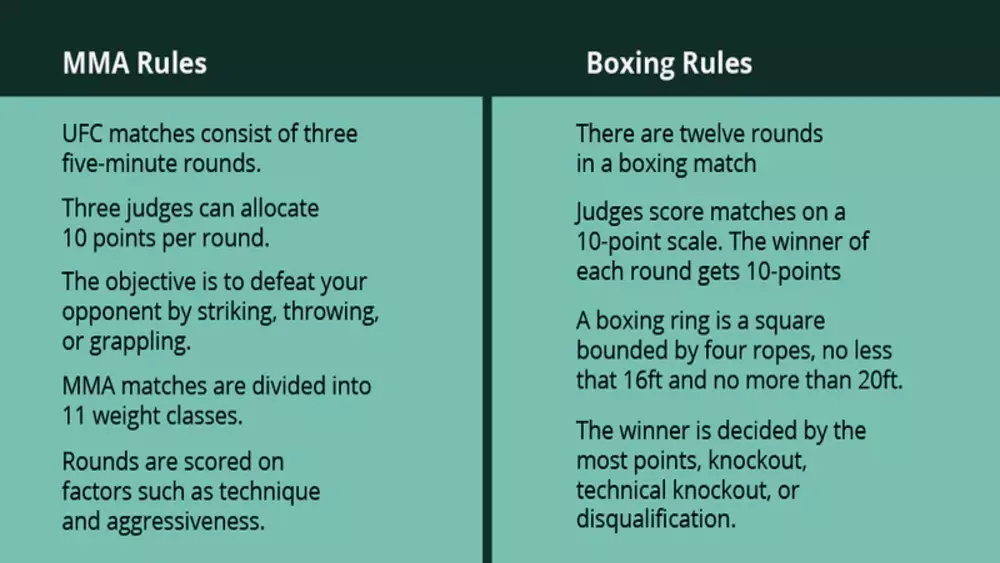Two combat sports disciplines stand out for their popularity and global fan base: boxing and mixed martial arts (MMA). While both sports involve striking and knockout potential, they fundamentally differ in rules, techniques, strategies, and overall dynamics.
To understand these differences better, let’s compare Boxing Vs MMA Fight Comparisons in detail.
1. Fighting Techniques

One of the most significant differences between boxing and MMA is the range of fighting techniques allowed. In boxing, fighters are limited to punches, focusing solely on strikes with their fists. The sport emphasizes footwork, head movement, and defensive techniques like blocking and dodging.
MMA, on the other hand, is a hybrid sport that allows a wide variety of fighting styles. It includes striking (punches, kicks, elbows, and knees) and grappling (wrestling, submissions, and takedowns). Fighters can utilize a mix of martial arts disciplines such as Brazilian Jiu-Jitsu, Muay Thai, wrestling, and karate, making MMA more versatile in combat techniques.
2. Rules and Regulations

Boxing follows strict rules, limiting fighters to using only their fists. A standard boxing match consists of up to 12 rounds, each lasting three minutes, with one-minute breaks between rounds. The match is won through a knockout, technical knockout (TKO), or a judge’s decision based on points.
MMA is governed by the Unified Rules of Mixed Martial Arts, which permits a broader range of attacks, including kicks, knees, and submissions. MMA fights typically consist of three rounds for regular matches and five rounds for title fights, each lasting five minutes. Fighters can win via knockout, submission, TKO, or judges’ decision. MMA’s versatility allows for more varied fight outcomes, whereas boxing remains more predictable due to its focus on punches.
3. Fight Strategies

In boxing, strategy is primarily about timing, positioning, and precision. Boxers aim to land clean punches while avoiding their opponent’s strikes. Defensive skills like slipping, blocking, and counterpunching are critical to success. Fighters often spend years mastering these elements, honing their punching power, speed, and endurance.
MMA’s strategy is much more complex due to the multiple fighting styles involved. Fighters must be proficient in both striking and grappling. A common strategy in MMA is identifying and exploiting an opponent’s weakness—whether through striking, submissions, or ground control. This variety of tactics makes MMA more unpredictable, as a fighter skilled in submissions could win the fight without ever landing a single punch.
4. Fighter Conditioning and Durability

Both boxing and MMA require elite-level conditioning, but the type of conditioning differs between the two sports. Boxing demands exceptional cardiovascular endurance and the ability to absorb and deliver sustained punches over several rounds. Boxers train extensively for hand speed, power, and stamina, as most fights go deep into the rounds, often requiring mental toughness and physical endurance.
MMA fighters, on the other hand, must train for a wider range of physical challenges. They must be agile, flexible, and strong enough to handle various fighting styles, including grappling and wrestling. MMA conditioning involves striking, grappling, and ground control, making it arguably more demanding due to the variety of movements required. MMA fighters must prepare their bodies for multiple fight scenarios, whether on their feet or on the ground.
5. Knockouts vs Submissions
Boxing is famous for its dramatic knockouts, which can end a fight instantly. A well-placed punch, often to the chin or temple, can render a fighter unconscious, swiftly concluding the match. Knockouts in boxing are highly valued, and fighters often aim to secure a KO for an undisputed victory.
While MMA also values knockouts, submissions add another layer of intrigue. A fighter can win by forcing their opponent to tap out via chokeholds, joint locks, or other submission techniques. These submissions add a cerebral aspect to MMA that boxing lacks, as fighters must be adept at escaping dangerous positions and recognizing when a submission is imminent.
6. Ring vs Cage
Boxing matches occur in a ring, typically a square-shaped space with ropes on all sides. The ring allows fighters to move freely and encourages strategic footwork. Boxers often use the ropes to their advantage, bouncing off or cornering their opponents.
MMA fights are held in a cage, usually octagonal and enclosed with fencing. The cage limits a fighter’s movement, as there are no ropes to bounce off, and fighters can get pinned against the fence. This structure changes the dynamic of the fight, especially when it comes to grappling and takedowns, as fighters can use the cage for leverage.
7. Popularity and Marketability
Boxing has a long history and a dedicated global fanbase, with iconic fighters like Muhammad Ali, Mike Tyson, and Floyd Mayweather becoming household names. Historically, boxing events, especially heavyweight title fights, have drawn massive audiences and significant pay-per-view sales.
MMA is a relatively newer sport, but it has become popular thanks to organizations like the UFC. Fighters like Conor McGregor, Khabib Nurmagomedov, and Amanda Nunes have helped bring MMA into the mainstream, often competing in highly anticipated crossover events that attract millions of viewers. MMA’s multi-dimensional combat appeals to a broader audience who enjoy the sport’s unpredictable nature.
8. Injuries and Safety Concerns
Both sports carry inherent risks, but the types of injuries differ. In boxing, repetitive head trauma from punches can lead to long-term brain damage, including conditions like chronic traumatic encephalopathy (CTE). Knockouts are common, and fighters who avoid KOs can sustain significant damage over time.
In MMA, fighters are at risk for various injuries, including broken bones, ligament damage, and concussions. However, MMA’s ability to finish fights via submissions or grappling may reduce the frequency of severe head trauma compared to boxing. Nonetheless, both sports are dangerous, and fighters must carefully manage their health throughout their careers.
Faqs About Boxing Vs MMA Fight Comparisons
Which is more dangerous boxing or MMA?
Boxing tends to involve more repetitive head trauma, leading to long-term brain injuries like CTE. MMA, while still dangerous, allows for a wider range of fight outcomes, such as submissions, which may reduce the risk of head injuries compared to boxing.
Why do MMA fighters earn less than boxers?
Boxing is an older sport with a more established pay-per-view market, allowing top boxers to command larger purses. MMA is newer, and although it’s growing rapidly, its pay structure varies significantly from organization to organization.
Can a boxer win against an MMA fighter?
In a pure boxing match, a boxer has a significant advantage. However, the MMA fighter’s versatility, including grappling and submissions, would likely give them the upper hand in an MMA fight.
Is conditioning harder in MMA or boxing?
MMA fighters must condition themselves for a wider range of movements, including striking, grappling, and ground control, making MMA arguably more demanding regarding physical preparation.
Which sport is more popular boxing or MMA?
Boxing has a longer history and a well-established global following, but MMA is quickly gaining popularity, especially among younger audiences, thanks to its diverse fighting styles and dynamic events.
Conclusion
In conclusion, boxing and MMA offer two distinct combat sports experiences. Boxing focuses on striking with precision, timing, and power, while MMA embraces a more versatile approach, incorporating multiple martial arts disciplines.
Both sports have unique appeal—boxing’s rich history and knockouts versus MMA’s diversity of techniques and unpredictability. Whether one prefers boxing or MMA depends on individual taste, but both remain at the pinnacle of combat sports. If you’re a beginner looking to start with boxing, check out these best boxing workout routines for beginners to improve your skills and conditioning.


2 Comments
I really like your writing style, excellent info , appreciate it for putting up : D.
Great beat ! I wish to apprentice while you amend your site, how can i subscribe for a weblog site? The account helped me a appropriate deal. I had been a little bit acquainted of this your broadcast offered vibrant transparent concept